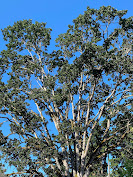The Value of a Tree
Economic Value
- Timber industry – Working forests comprise approximately 47% of Washington State forest lands which generates jobs, taxes, and production of wood & paper products. Rural counties benefit most from this industry because they offer ½ of timber jobs and produce about 80% of the annual harvest.1, 2
- Outdoor Recreation – Much of Washington’s outdoor recreation takes place in forests, parks, and other natural areas populated by trees. Not only do these activities generate tax revenue through consumer spending, they also attract out-of-state visitors and provide jobs (estimated to be 6% of WA jobs). 3
- Property Value and Utility Cost Saving – Trees can add value to a single residential property between 3% and 15%. Moreover tree-lined streets can add value to a neighborhood. 4 The U.S. Department of Agriculture estimates that “strategically placed trees save up to 56 percent on annual air-conditioning costs. Evergreens that block winter winds can save 3 percent on heating.” 5
Ecosystem & Environmental Value
- Habitat – For animals, trees provide shelter, places to raise their young, and sources of food (through seeds, nuts, fruits, bark, and roots). they also host a variety of members of the food chain. 6
- Clean Air – The U.S. Department of Agriculture states “one acre of forest absorbs six tons of carbon dioxide and puts out four tons of oxygen. This is enough to meet the annual needs of 18 people.”
Health & Well-Being Value
- Air Quality – Every tree helps remove pollutants from the air; the USDA estimates that “100 trees remove 53 tons of carbon dioxide and 430 pounds of other air pollutants per year.”
- Water Quality – Rainwater and snow melt enter our watersheds with the help of tree canopies which slowly release water into the soil and then filter pollutants through their roots with the help of other vegetation. This process also helps to prevent storm water runoff,flooding, and reduce erosion and flooding. 7
- Mental State & Health – Walking among trees can reduce anger, fear, depression, and stress as well as lower blood pressure and improve sleep. Nature can also improve cognitive ability. Even just looking at nature contributes to our healing from an illness. 8, 9, 10
What can you do?
Plant a young tree in your yard, a neighbor’s yard or in a public space, with permission of course.
Select a tree carefully and learn how to take care of it.
Take more walks in wooded areas and bring a friend or family member.
Celebrate Arbor Day in your community.
Encourage your community to preserve
wooded areas and limit tree removal in both residential and commercial areas. Protect trees for
the long term.Support a local tree preservation group: Lakewood Garry Oak Conservancy, Tacoma Tree Foundation.
_______________________________________________________
References
(1) Forest Industry Economic Impact 105000 Jobs and $4.9 Billion in Wages
(3) Economic Analysis of outdoor Recreation in Washington State
(7) Working Trees for Water Quality
(8) Immerse Yourself in a Forest for Better Health
(9) How Does Nature Impact Our Well being?
(10) Nature-based Design

